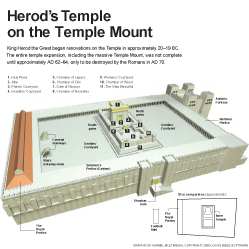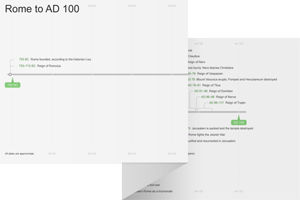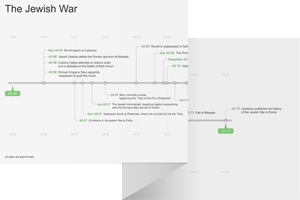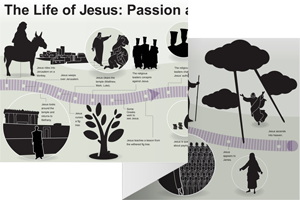13:1–36 Jesus’ departure from the temple leads to His prediction of its destruction. This prompts questions from the disciples about when these events would happen (vv. 3–36). Jesus responds by discussing portents (or signs) of the arrival of God’s kingdom and His own climactic return. His teachings have practical significance for His followers: They must remain alert and loyal while waiting for Him (vv. 32–37). |
13:1 what wonderful buildings The plural form used in the Greek text here suggests that the disciple probably is commenting on the courts (or buildings) surrounding the temple, not just the temple itself.
13:2 Not one stone will be left here Jesus might be predicting the destruction of the temple, which happened in ad 70 at the hands of the Romans. He also refers to His own body as the temple (14:58; 15:29; John 2:19).
13:3 Peter and James and John and Andrew Describes the “inner circle” of Jesus’ disciples; they occasionally witness events that the rest of the disciples do not participate in (compare Mark 5:37; 9:2).
13:4 these things The disciples might be asking about the destruction predicted in v. 2 or about other events related to God’s coming kingdom.
13:6 Many will come in my name Indicates that other people will claim to be the Messiah.
13:7 the end Refers to the end of the present age (which is followed by the age to come). See note on 1:15.
13:8 birth pains This reference to pains experienced in labor is a common prophetic image for divine judgment (Isa 13:6–8; 66:7; Mic 4:9–10). In Jewish apocalyptic literature (e.g., 1 Enoch 62:4; 2 Baruch 22:7), imagery of birth pains came to refer to a final period of hardship preceding the full establishment of God’s reign at the end times.
13:10 first be proclaimed to all the nations Jesus speaks explicitly about a Gentile (non-Jewish) mission, which His actions in the regions surrounding Galilee have anticipated (Mark 5:1–20; 7:24–37).
13:14–23 Using apocalyptic language, Jesus warns that before He returns an abomination of desolation will affect the entire world. |
13:14 the abomination of desolation In this context, this phrase could refer to some worldwide or regional catastrophe (see vv. 19–20). It also could indicate the Romans’ attack on Jerusalem and destruction of the temple in ad 70.
flee to the mountains During the First Jewish Revolt (ad 66–70), many who lived in Jerusalem attempted to flee the city to avoid the violence between the Romans and the rebels.
13:20 Lord had not shortened the days To save His people, God will curtail the period of tribulation. The idea of the elect is rooted in the ot understanding of Israel’s identity and vocation as chosen by God (Deut 7:6; 14:2). In Jesus’ time, it also could be used to refer to a portion of Israel considered to have remained faithful to God’s covenant amid the general disobedience of the nation (Isa 65:8–10; as seen in the Dead Sea Scrolls’ document, Rule of the Community 8.1–6).
13:22 false messiahs and false prophets A false messiah pretends to be God’s agent of deliverance, and a false prophet pretends to be God’s messenger.
13:24 the sun will be darkened Indicates that cosmic dysfunction of some sort will be a sign of the Son of Man’s coming. Mark’s imagery draws on a number of prophetic motifs (e.g., Joel 2:30–31; Ezek 32:7–8).
13:26 the Son of Man arriving in the clouds Refers to Jesus’ return. See note on Mark 2:10..
13:27 gather the elect together Presupposes a time when God’s people are spread around the globe. The scene evokes a prophetic motif about the ingathering of Israel to the promised land (e.g., Jer 30–31).
13:28–31 Jesus again uses the fig tree as an example of judgment (Mark 11:12–14, 20–25). The point of this parable is that the presence of leaves clearly indicates the changing season, just as the cosmological signs indicate the changing eras. |
13:28 fig tree The fruitless fig tree in 11:14 symbolizes Israel’s corrupt religious leaders as the object of judgment; here, a fruitful fig tree, which may refer to positive work coming from God’s people, is a sign of the imminent coming of the kingdom of God.
Parable of the Fig Tree | ||
13:30 this generation will never pass away Jesus seems to be referring to the present age of humanity (before God’s rule is fully established; compare note on Mark 1:15; note on Gal 1:4). The context of Jesus’ remarks is the final judgment (Mark 13:26–27), which will occur at a time known only to the Father (v. 32). This seems to rule out the possibility that Jesus is referring only to the generation of people in His day.
13:32–37 The above predictions and signs of the age to come are held in tension with Jesus’ teaching that only the Father knows the day and hour. For Jesus’ followers, the implication is that they must be alert and ready for the appearance of the Son of Man at any time (vv. 34–36). This means, primarily, that His followers should continue His mission of proclaiming the good news of the kingdom of God. |
13:34 gave his slaves authority Compare 12:1–12.
13:35 be on the alert When Jesus leaves, He tells His followers to proclaim the gospel in all the world (v. 10; compare Matt 28:16–20; Acts 1:6–9). Remaining alert requires expectant faithfulness to Jesus until He returns in glory.
whether in the evening The time references here parallel four markers in the Passion Narrative that follows: the evening Passover meal (Mark 14:17), Jesus’ nighttime arrest in Gethsemane (14:41), His arraignment before the temple leaders when the rooster crows (14:68, 72), and His appearance before Pilate when morning comes (15:1).
13:37 everyone Jesus clarifies that His charge to remain alert is for all who follow Him, not simply the four disciples who are present for this teaching (v. 3).

|
About Faithlife Study BibleFaithlife Study Bible (FSB) is your guide to the ancient world of the Old and New Testaments, with study notes and articles that draw from a wide range of academic research. FSB helps you learn how to think about interpretation methods and issues so that you can gain a deeper understanding of the text. |
| Copyright |
Copyright 2012 Logos Bible Software. |
| Support Info | fsb |
 Loading…
Loading…






